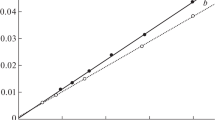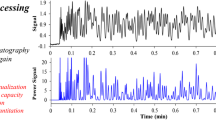Summary
A new index of performance of the chromatographic separation between two adjacent peaks, the discrimination factor, d0, is defined. It is normalized between 0 and 1 and is directly and easily determined from the chromatogram. It does not depend on any assumption regarding peak shape, except that the peak profiles of individual sample components have a single mode. Its value depends on the relative heights of the two peaks as well as on their separation.
The separation power of a chromatographic system is classically measured by its peak capacity, defined on the basis of constant resolution between adjacent peaks. A previously developed statistical theory of the composition of mixtures makes it possible to extend the concept of peak capacity by taking into account the peak height distribution in typical average chromatograms. A new parameter, the effective peak capacity, is defined for this purpose on the basis of a constant discrimination factor between adjacent peaks. It allows to take into account the distribution of peak heights in statistical theories of the evaluation of complex chromatograms and in the measurement of the limit of determination in quantitative analysis.
The characteristics of the two new parameters, the discrimination factor and effective peak capacity, are discussed and compared with those of their classical homologs, resolution and peak capacity, in the case of gaussian component peaks of equal widths.
Similar content being viewed by others
References
D. Rosenthal, Anal. Chem.54, 63 (1982).
J. M. Davis, J. C. Giddings, Anal. Chem.55, 418 (1983).
M. Martin, G. Guiochon, Anal. Chem.57, 289 (1985).
J. M. Davis, J. C. Giddings, Anal. Chem.57, 2168 (1985).
M. Martin, D. P. Herman, G. Guiochon, Anal. Chem.58, 2200 (1986).
J. C. Giddings, Anal. Chem.39, 1027 (1967).
M. Martin, G. Guiochan, “Statistical theory of the composition of mixtures. Application to the estimation of the number of theoretically detectable components by chromatography”, Communication presented at the 9th International Symposium on Column Liquid Chromatography, Edinburgh, July 1–5, 1985.
D. Ambrose, A. T. James, A. I. M. Keulemans, E. Kovats, H. Röck, C. Rouit, F. H. Stross, in “Gas Chromatography 1960”,R. P. W. Scott, ed., Butterworths, London, 1960; p. 423.
E. Grushka, Anal. Chem.44, 1733 (1972).
L. R. Snyder, J. Chrom. Sci.10, 200 (1972).
R. Kaiser, “Chromatographie in der Gas Phase. I. Gas-Chromatographie”, Bibliographisches Institut, Mannheim, 1960; p. 16 and 35.
R. Kaiser, “Chromatographie in der Gas Phase. III. Tabellen”, Bibliographisches Institut, Mannheim, 1962; p. 148.
R. Kaiser, “Chromatographie in der Gas Phase. II. Kapillar-Chromatographie”, Bibliographisches Institut, Mannheim, 1961; p. 32.
R. Kaiser, “Gas Chromatographie”, Akademische Verlagsgesellschaft Geest & Portig K.-G., Leipzig, 1960; p. 33.
L. S. Ettre, J. Gas Chromatogr.,1, 36 (1963).
A. B. Christophe, Chromatographia,4, 455 (1971).
M. Martin, M. Z. El Fallah, unpublished work.
A. I. M. Keulemans, A. Kwantes, G. W. A. Rijnders, Anal. Chim. Acta,16, 29 (1957).
Since the beginning of this work and the submission of a related abstract for communication to a symposium [20], we have been informed that a criterion very similar to do has been independently suggested bySchoenmakers [21].
M. Z. El Fallah, M. Martin, “Extension des concepts de résolution et de capacité de pics en chromatographie”, Communication presented at the 4th Congress of Analytical Chemistry — 36th Congress of GAMS, Paris, December 8–13, 1986.
P. J. Schoenmakers, “Optimization of chromatographic selectivity”, Journal of Chromatography Library, Vol. 35, Elsevier, Amsterdam, 1986; p. 121–123.
M. Z. El Fallah, M. Martin, submitted to publication.
A. Stolyhwo, H. Colin, M. Martin, G. Guiochon, J. Chromatog.288, 253 (1984).
W. L. Creten, L. J. Nagels, Anal. Chem.59, 822 (1987).
L. J. Nagels, W. L. Creten, P. M. Vanpeperstraete, Anal. Chem.55, 216 (1983).
Author information
Authors and Affiliations
Rights and permissions
About this article
Cite this article
El Fallah, M.Z., Martin, M. Influence of the peak height distribution on separation performances: Discrimination factor and effective peak capacity. Chromatographia 24, 115–122 (1987). https://doi.org/10.1007/BF02688473
Received:
Accepted:
Issue Date:
DOI: https://doi.org/10.1007/BF02688473




